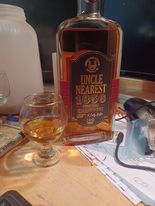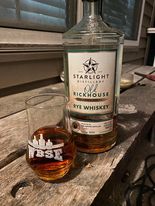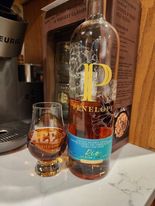West Bottoms Whiskey Company is a relative newcomer to the distilling world with a strong historical identity. Nestled in the West Bottoms District of Kansas City, the distillery was founded in 2016 by Alex Lindsey and Cassandra Benavidez with a vision for creating whiskey connected to the community it’s distilled in. Their first release, West Bottoms Kansas City Whiskey, reflects this: the whiskey is a recreation of a pre-prohibition recipe unique to Kansas City. A blend of bourbon, rye, and oloroso sherry – not finished in sherry casks, but blended with sherry itself. The taste is uniquely fruity and spicy, and is only made by a couple of distilleries in Kansas City.
The first thing I noticed when visiting the distillery was its location. It’s truly right in the heart of a historical urban district. The buildings are all from the 19th century; when built, they were factories and cattle trade houses; now they’re salons, piano shops, coffee houses, apartments. This district was where goods flowed in and out of Kansas City. Topically, that included whiskey. The significance of this location isn’t lost on Alex. As we walked back to his office through the cocktail parlor and loading area, he pointed out different historical spots in the building – an elevator rode by President John Adams’ grandson here, the long open room that was once a train station there.
Like the building his distillery is founded in, Alex himself oozes passion for historical identity. I met Alex just three weeks before this interview, and our first conversation revolved around both personal histories and the history of the place we reside in. Alex clearly believes that the history of a place is integral to the identity of the people that reside there. Across many cities in the United States, and Kansas City in particular, this history includes whiskey-making. It’s this history that Alex hopes to tap into with his whiskey.
I sat down with Alex to discuss his love for whiskey, his vision for West Bottoms Whiskey Company, and his pursuit of legally designating Kansas City whiskey as a defined historical product.

Tell me about your background in whiskey. What are some early memories of whiskey, and how did your taste develop?
So, I’m not trained in this. I don’t have a degree in this. I fell in love with the distillation, especially whiskey, by just trying things and reading. Self-taught. I went to some classes, talked to a lot of other distilleries across the country, and devoted a lot of my spare time to creating whiskey mostly just because I really, really, loved it. And the cool thing about whiskey for me and what I thought I could build a business around was the idea of whiskey as a story – there’s a story in every drop of whiskey that you drink. It is by definition aged – it has to sit in the barrel. So there is time and there is intention in it. There is purpose behind that and that’s what I really love about it.
My first memories of whiskey… Honestly, I don’t really have many as a kid. My folks didn’t drink too much, that I can remember. As an adult I spent a short period of time living in Florida and honestly hated it. I don’t tell a lot of people this, but I spent a lot of time in Florida, hated it, really was longing to get back to Kansas City. I really wanted to get back home where I’m from and I wanted to connect to those Midwestern roots and whiskey was a nice way for me to do that while I was trying to get back to Kansas City, so I started drinking and exploring whiskies back then. Whiskey is based in grain. Grain is all around Kansas City. It’s all around the Midwest. There’s a connection in that sense. And that’s when I really started to appreciate what whiskeys were. It became a rabbit hole of just understanding what it was and what I’m drinking and why I like the things that I like much like a lot of other people when they get introduced to whiskey. That was an experience that I would really like to help create with our whiskies as well creating something that is approachable and that allows people to connect with something that is fundamentally true to them.
So when it comes to flavor profiles and whiskeys that I like, I first look for approachability. When I drink whiskeys and when I have a whiskey that I sip, or that I try for the first time and it really pops for me a lot of the characteristics around that are the complexity level. There’s a drinkability factor that has to happen too. I’ve made whiskeys in the past that were just too simple. I mean, would they sell? Yeah, holy crap they would. But they’d be too one-note. To me whiskies that offer complexity, a good mouthfeel, those caramel notes that people really love, are all great. The more complexity to a whiskey and the more diverse a flavor profile is, that just means more story and that is a really cool thing that I want in my whiskey.

You’ve talked about story and history in whiskey and being passionate about that. How do you see that in your vision for the distillery?
The first part of that was coming up with the brand itself, our figurehead, Murdoch. He’s a top-hatted, monocled, industrial gear jawed gentleman and our identity is built around that. He represents that post-industrial Revolution era where the country was changing dramatically from a technological and sociological standpoint, from the rich and the poor standpoint. It was all evolving very quickly, and it was an optimistic time to be alive in America. And then with all that innovation in the industry that was happening at that time. Murdoch, to us, represents that dichotomy of the rich and the poor, the people that were working and the people that were visionaries during the late 1800’s and early 1900’s. He represents that pre-prohibition era. That image was a huge thing because that’s something that could be sold, and that’s something that could be rallied around. It put an actual picture to what I valued. That was the turning point for me to say, OK, I can actually turn this vision of a distillery into a business. From there, it obviously it morphed a lot. I wrote up a business plan. I had big grandiose ideas of what a distillery looks like. Of course, there’s a cookie cutter pattern you can follow. You can make a vodka. You can make a gin. You can make a rum. You can get a whiskey or you can source a whiskey until you can make and age your own thing. I wanted to do something a little bit different and just focus on whiskey itself. I found our train tunnel down here in the West Bottoms. I found this space and I was like, there’s a ton of history here. There’s a ton of history that I love about this area and we can really build a story around that and actually make a whiskey here. I can produce something cool.
I really do want to tap into the history in this area with my distillery. Union depot was just a few blocks away from us in the early 1900s, and that’s where the trains came into Kansas City. That’s where the cattle were unloaded. That’s where the stockyards, the meat packing and the processing were. They got shipped to Chicago and to New York from there. It was this was a major hub for Kansas City. When it comes to Gully town (the lower part of Kansas city, near the Missouri River), for instance, there were the Irish and Scottish immigrants that came over and settled there. They brought with them decades and centuries of knowledge of home distillation, kind of how I started. And for them, distilling was almost a necessity. They’d have excess grain, and it would go bad if they couldn’t sell it. What doesn’t go bad is whiskey. You can distill that grain, turn it into whiskey. Yeah, the stories here are a huge part of Kansas City cultural history, which is important to remember. I want to carry on the influence of those immigrants and their knowledge in what I’m doing here.

The second part was coming up with our flagship whiskey. I wanted that to be something connected to this City and its history, and that’s where Kansas City whiskey comes in. Kansas City whiskey as a style and as a brand has a lot of legs. It’s been proven before by J. Reiger (another distillery in Kansas City) who’s got a storied history with this style. As a whiskey it’s a solid product and I’m proud of creating it no matter what happens to West bottoms whiskey Co. It’s a custom blend that was put together from a sourced bourbon, a sourced rye, and a dry oloroso style Sherry from Spain. We blend it together at a 94 proof, and putting that together for us was really exciting and important and I’m so glad that people appreciate it for what it is. I would love to get Kansas City whiskey out to even more people and turn it into an actual staple for a lot of people across the country. For us as a company though, I didn’t start a distillery to basically just blend or rectify. I wanted to distill products. So right now we’re working on producing two different whiskeys here in the next few months. The first one is going to be our distiller’s cut. That’s an American single malt, a new blend of our new style of whiskey to the United States. The Scotch finally let us have that malt whiskey title and I’m really excited to get ours out there. That was distilled, fermented, distilled and aged in house.
The second release will be a blended malt. We’re going to be taking our distillers cut and blending that with a barrel of single malts. It’s 100% malted barley, not peated or anything like that. Our single malt is a 50%, two row barley, malted barley, and peated malt. So you get that Scotch effect a little bit, but we’re also blending that with a 100% malted barley that’s a four year old single malt whiskey as well. We’re super excited to get these products out there so people can try them!

So I want to go back and touch on the Kansas City whiskey. You’ve mentioned it has a storied history as a product and other distilleries in the City make it as well. Could you tell me more about that?
For sure. So by definition, Kansas City Whiskey is a whiskey blend that is up to 2 ½% Sherry. It’s a pre-prohibition style of whiskey. It’s pretty unique and to really understand that style of whiskey and then to understand why it’s designated as Kansas City whiskey you have to understand that time period. So, Kansas City has a rich drinking history down here in the West bottoms. It especially has quite a deep, rich history when it comes to drinking in America. And that history includes talking about prohibition. Prohibition in America happened for a reason, right? Whether it was smart or not, I don’t think prohibition in general works. Obviously it didn’t work here in the United States, but to understand what led to prohibition, you have to understand that pre-prohibition era. People were drinking a lot back then and I can’t overemphasize that enough – people were drinking a lot. So the aged whiskey supply in America was drying up. People couldn’t keep up. So the government passed a law that allowed you to add up to 2 ½% of a fortified Sherry wine to your blend for whiskey products. That was great because it gives flavor and color to what were otherwise young, immature or just flat out nasty whiskies back then. You can find old articles in newspapers that were advertising bulk, sharing order Sherry, and the people buying that weren’t you and I, right? Who’s going to buy 200 gallons of Sherry at one time? Those were manufacturers and whiskey distillers at that point. And that is because of that rectifying process. This was something that was pretty unique to Kansas City – not a lot of other places were using this process. So it’s important to Kansas City history and to drinking history in America.
Right now it’s not a legal designation, but you and a few others in KC have been pursuing that. What has that process looked like and where is it right now?
Making Kansas City whiskey an actual designation is really exciting. There have been three people that have produced Kansas City whiskey that we know for sure. There are obviously state designations – there’s Tennessee whiskey, Kentucky, Scotch, Bourbon. There’s Missouri Bourbon now, which is amazing. But when it comes to Kansas City whiskey, you’re telling a little bit of a bigger story when it comes to that. As far as I know right now there is no specific city designation for a spirit, so we would be the first if we are able to accomplish that. J. Reiger is the big driving force behind that because of their brand. We as a distillery are also pushing to make that style of whiskey a designation because it’s approachable to a lot of different people. It tells a different kind of story about whiskey that is really embedded into American history, that a lot of people don’t know about yet, and that’s part of our goal in our in our brand.
To answer your question about where we are in the process – we’re still in the days of education. We’re trying to get people to understand what it is. We need buy in from our friends, from the people we work with, and the people we work closest with. We need to get more and more of those other distilleries in Kansas City and Missouri on board. Once we get forward momentum there, it’ll go to the Missouri government first, then beyond that federally. To have that recognition as a distinct style of whiskey would be huge. Again, it would be the first city designation of a spirit, which would be such a cool thing.

To wrap up, I’m going to hit you with our Mashbill questions. Five quick hitters. Ready?
“Yep, let’s do it.”
What was the last whiskey, bourbon or Scotch in your glass?
Other than Kansas City whiskey, it was Bruichladdich, the Classic Laddy. I love it. We’re about to release our blended malt whiskey which was inspired by Bruichladdich.
Do you prefer to drink your whiskey from a specific type of glass?
The older the glass, the better. The style doesn’t really matter to me. Our tasting glasses are shaped after what are more traditional juice glasses or just throw back glasses – what men and women drank whiskey with years ago. I just love the history.
What is your unicorn bottle?
I haven’t made it yet. I know you mean bottle made by someone else, but for me, my unicorn bottle is the one I create that will one day be sought after by others.
I’m looking for a gift for a friend. The budget is $50 to $75. What would you recommend?
Any local whiskey that you can find, whether you are reading this in Minnesota, Alaska, wherever – someone is making whiskey near to you, support those people. There is story and intention behind whatever that distiller or that producer is doing. And if you like how it tastes and you want to share that with a friend or a family member it goes a long way and it helps. Tell whatever story that that distiller is telling. That’s what I would absolutely recommend.
What’s your favorite toast?
To trying and crying. To winning and grinning. Life can be tricky, but it’s better with whiskey. Cheers.
On behalf of the Whiskey Network, thank you for your time and perspective!
Thanks to Alex Lindsey for taking the time to interview with me. I enjoyed hearing his perspective on Kansas City and its whiskey history. To Alex and Cassandra, welcome to the Whiskey Network Family! We look forward to following the growth of Kansas City whiskey as a designated historical product and hope to see that achieved soon.
Please visit West Bottoms Whiskey Co. for more information.









